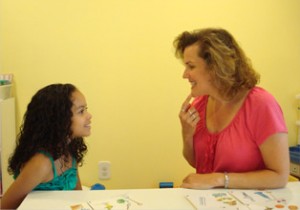How to Teach the “Ch” Sound
The “Ch” Sound
The “ch” sound is produced by touching the tip of the tongue to the roof of the mouth to block the passage of air very briefly before releasing it through the mouth. Say “chicken.” Notice how the tip of your tongue touches the roof of your mouth just behind your front teeth? You might also notice that your lips pucker slightly and that your vocal cords do not vibrate when pronouncing the “ch” sound. This sound is a voiceless stop consonant. It combines the “t” and “sh” sounds.
Children typically begin to articulate the “ch” sound by the age of three and a half. They usually master the sound by the age of seven. If your child exhibits a delay in articulating this sound, seek the services of a speech-language pathologist (SLP). The SLP will likely provide you with “homework” to do between speech therapy sessions to accelerate your child’s progress.
Visual Demonstration
Sit down with your child for an educational play session. You’ll need a box of tissues. Demonstrate the “ch” sound visually by pretending to sneeze. Exaggerate the “ahhh – CHOOO!” and pretend to sneeze into a tissue. Encourage your child to imitate you. You can also make a big fuss out of scratching your arm while saying “itchy!” If he has trouble making the sound, have him watch your face closely while you say words like “chicken,” “choice,” and “ketchup.”
Verbal Demonstration
If your child can already articulate the “t” and “sh” sounds, you can use these sounds to elicit the “ch” sound. Instruct your child to say the “sh” sound, but to hold his tongue on the roof of his mouth. Have him feel the built up pressure before he releases the air out of his mouth. You can also challenge your child to a tongue twister game. Ask him to say “it’s you” over and over again. Gradually, these sounds will combine until it sounds like the “ch” sound.
Tactile Demonstration
The use of tactile feedback is a great tool for teaching individual sounds. With Speech Buddies, your child has a target inside his mouth so that he knows when his tongue is correctly positioned. Place the CH Speech Buddy so that the bend is directly behind the back front teeth. Instruct your child to touch the tip of his tongue to the target and practice making the “ch” sound. Watch the CH Speech Buddy video for more information on using this device.
Games with the “Ch” Sound
Make speech therapy fun by introducing your child to games that teach the “ch” sound. If your child loves toy trains, play with them on the floor. Say “Choo choo!” frequently and encourage your child to join in.
Make a game out of naming as many animals as you can with the “ch” sound. You and your child could draw these animals as both of you name them. Some examples are cheetahs, chickens, Chihuahuas, and chickadees.
Make a game out of naming everyday objects with the “ch” sound. Walk through your home with your child and encourage him to name objects like a chair, a couch, a slice of cheese, and the kitchen.
As your child masters the “ch” sound, encourage him to incorporate “ch” words in sentences. Make up a silly story about a little girl named Charice who ate chocolate and had a pet Chihuahua who slept on the couch. Encourage your child to expand on your story.





